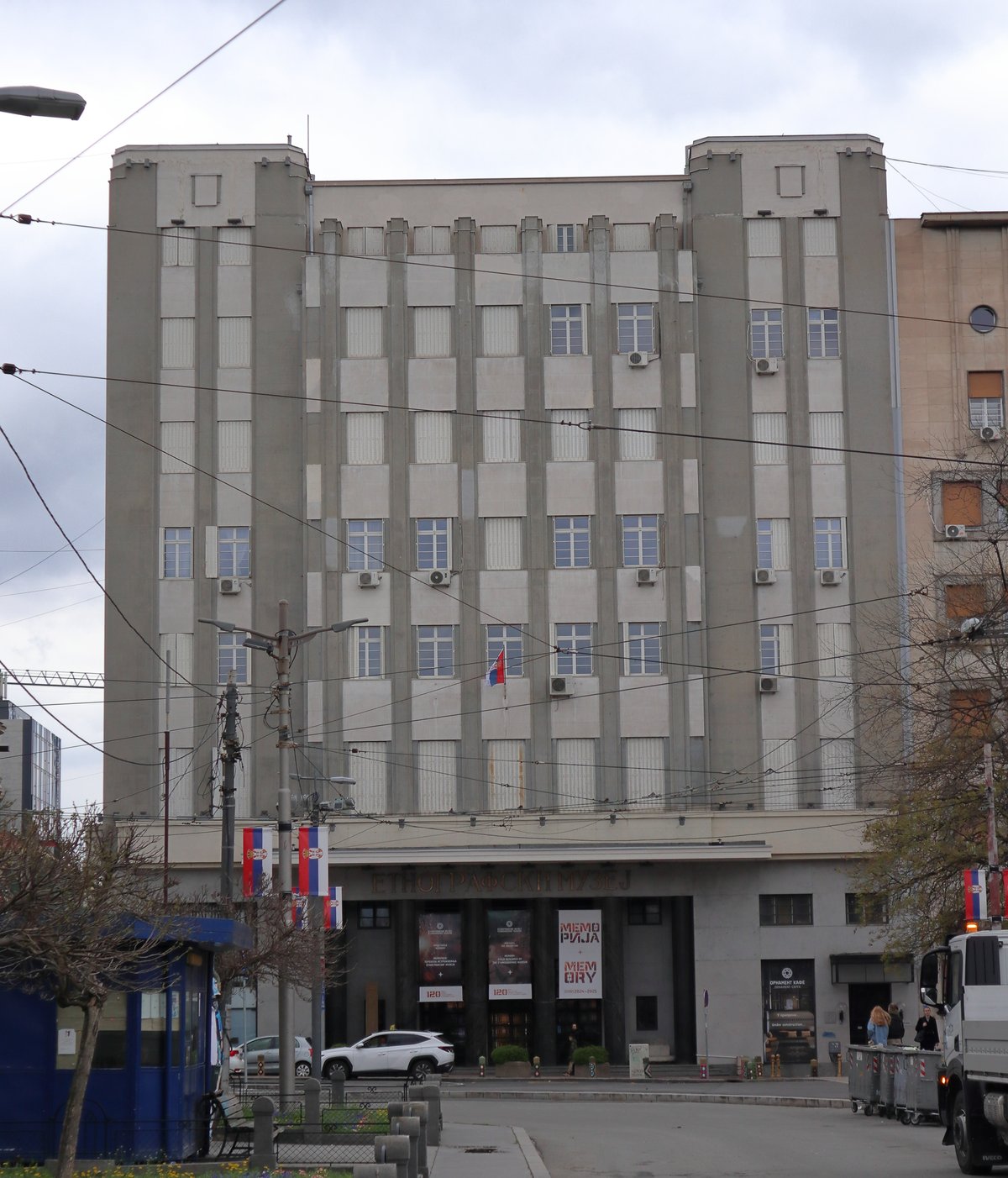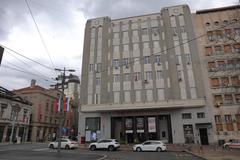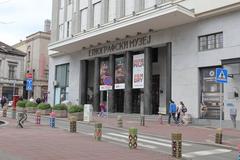
Ethnographic Museum Belgrade: Visiting Hours, Tickets, and Visitor Guide
Date: 14/06/2025
Introduction
Situated in the vibrant heart of Belgrade, the Ethnographic Museum Belgrade stands as a leading institution dedicated to preserving and presenting the rich cultural tapestry of Serbia and the Balkans. Established in 1901, the museum was inspired by historian Stojan Novaković and the Serbian Academy of Sciences and Arts, with its founding timed to coincide with the centenary of the First Serbian Uprising—symbolizing a national recognition of the value of cultural heritage (Feel Serbia). Today, it houses over 120,000 artifacts, including traditional costumes, household items, ritual objects, and jewelry, chronicling centuries of daily life and customs.
Visitors can expect thoughtfully curated exhibitions, interactive workshops, and a blend of historic architecture with modern accessibility. The museum’s location near iconic sites such as Kalemegdan Fortress and Knez Mihailova Street makes it an essential stop for anyone interested in Belgrade’s historical and cultural landscape (Belgrade ePass). For current visiting hours, ticketing, and special events, consult the official museum website.
Museum History and Cultural Significance
Founding and Development
Founded in 1901 as an independent institution, the museum’s roots extend to the National Museum’s former ethnographic department. Its early mission was to collect, study, and exhibit artifacts reflecting the diverse cultural traditions of Serbia and the wider Balkans (Feel Serbia). The first permanent exhibition opened in 1904, aligning with national efforts to celebrate and preserve cultural identity.
Growth and Resilience
Despite significant losses during World War I, the museum rapidly expanded its collections post-war, focusing on field research and systematic categorization of artifacts by materials and use. The interwar period saw the creation of specialized departments and a commitment to both tangible and intangible heritage, including oral traditions and music.
Architectural and Institutional Value
Housed in a striking early 20th-century building, formerly the Belgrade Stock Exchange, the museum blends academic classicism with local design elements (galerijeimuzeji.rs). Renovations have preserved its historic character while modernizing exhibition spaces for contemporary visitors.
Contemporary Mission
As a leader in ethnographic research, the museum fosters intercultural dialogue and education, offering workshops, lectures, and international collaborations. Its commitment extends to documenting minority and urban cultures, ensuring exhibitions remain relevant and inclusive (Tourist Organization of Belgrade).
Visitor Information
Location & Getting There
- Address: Studentski trg 13, 11000 Belgrade, Serbia
- Public Transport: Easily accessible via bus (lines 26, 27, 31) and tram (lines 2, 12); a short walk from Republic Square and Knez Mihailova Street (serbia.com).
- By Taxi: Official taxis are widely available; always request a receipt.
Visiting Hours
- Tuesday–Saturday: 10:00–17:00
- Sunday: 09:00–14:00
- Closed Mondays
Always check the official website for updates, especially on public holidays or during special events (kasadoo.com).
Ticket Prices
- Regular: 150 RSD (~€1.30)
- Reduced (students with ID): 60 RSD
- Groups (10+): 100 RSD per person
- Free entry: Sundays for all, children under 6, and Belgrade Card holders (belgradecard.rs)
Tickets are available at the entrance; advance booking is recommended for groups or guided tours.
Facilities and Accessibility
- Restrooms & Cloakroom: Available on-site.
- Museum Shop: Books, souvenirs, and artifact replicas.
- Guided Tours: In Serbian and English; advance booking recommended (galerijeimuzeji.rs).
- Digital Experiences: Mobile app, MP4 audio guides, and augmented reality features enhance visitor engagement (diplomacyandcommerce.rs).
- Accessibility: Efforts have been made to improve access, but some areas may be challenging for those with mobility issues; contact in advance for details.
Exhibitions and Highlights
Permanent Exhibition
The core exhibition, “Folk Culture of Serbs in the 19th and Early 20th Centuries,” features over 5,000 artifacts from a collection of 51,000 (galerijeimuzeji.rs). Key highlights:
- Traditional Costumes: Regional folk attire with intricate embroidery and weaving.
- Household Items: Furniture, tools, and everyday objects from rural and urban settings (kasadoo.com).
- Model Homes: Reconstructions reflecting architectural diversity.
- Crafts and Trades: Displays on agriculture, crafts, and traditional industries.
- Religious Objects: Artifacts related to Serbian Orthodox and family customs.
Temporary Exhibitions and Events
Regularly hosted exhibits focus on folk art, crafts, and contemporary research. The annual International Festival of Ethnological Film attracts global interest (galerijeimuzeji.rs). Check the museum’s site for current programming.
Interactive and Digital Features
- Mobile App: Guided tours in Serbian and English.
- Augmented Reality: Select exhibits offer immersive digital experiences.
- Touchscreen Maps: Explore artifact origins and regional diversity (diplomacyandcommerce.rs).
Planning Your Visit
Duration and Timing
- Recommended time: 1–2 hours for the permanent exhibition; more for special events or workshops.
- Best time: Mornings and weekdays are quieter; Sundays are free but busier.
Photography
Non-flash photography is generally allowed. Check for restrictions in temporary exhibits.
Language
Most labels and digital features are bilingual (Serbian/English); guided tours deepen the experience.
Food & Refreshments
No café on-site, but numerous restaurants and coffee shops are nearby, particularly on Knez Mihailova Street.
Nearby Attractions
- National Museum of Serbia: Art and archaeology collections (serbia.com).
- Knez Mihailova Street: Main pedestrian and shopping area.
- Kalemegdan Fortress: Historic fortress and park with panoramic views.
Frequently Asked Questions (FAQ)
What are the Ethnographic Museum Belgrade visiting hours?
Tuesday–Saturday: 10:00–17:00; Sunday: 09:00–14:00; closed Mondays.
How much do tickets cost?
150 RSD regular, 60 RSD reduced, 100 RSD for groups, free on Sundays and for children under 6.
Is the museum wheelchair accessible?
Some areas may be challenging; contact the museum in advance for accessibility information.
Are guided tours available in English?
Yes, advance booking recommended.
Can I use a Belgrade Card for free entry?
Yes, Belgrade Card holders enter free.
Are there digital or interactive experiences?
Yes, including a mobile app and augmented reality features.
Visuals and Media
To enhance your visit, seek out images of the museum’s facade, folk costume displays, and interactive exhibits. Use descriptive alt tags such as “Traditional Serbian folk costume exhibit” or “Augmented reality at Ethnographic Museum Belgrade” for accessibility and SEO. Consider exploring a virtual tour if available on the museum’s website.
Booking and Contact
- Official Website: www.etnografskimuzej.rs
- Phone: +381 11 3281 888
- Email: [email protected]
- Address: Studentski trg 13, 11000 Belgrade, Serbia
For group bookings, guided tours, or accessibility inquiries, contact the museum directly.
Practical Tips
- Payment: Cash (Serbian dinars) preferred; some services may accept cards.
- Luggage: Store large bags in the cloakroom.
- COVID-19: Check the museum’s website for current health protocols.
- Safety: The area is safe and well-trafficked.
Conclusion
The Ethnographic Museum Belgrade is a cornerstone of Serbian culture, offering a fascinating blend of history, tradition, and innovation. Its central location, diverse collections, and commitment to education make it a top destination for history enthusiasts and casual visitors alike. For up-to-date information, download the museum’s app and follow official channels for news on events and exhibitions.
Summary and Encouragement
The Ethnographic Museum Belgrade is more than a repository of artifacts—it’s a living center for cultural discovery and dialogue. With accessible pricing, multilingual services, digital enhancements, and a prime city-center location, it welcomes all to explore the depth and diversity of Serbian and Balkan traditions. Allocate ample time to immerse yourself in the exhibitions, and don’t hesitate to participate in workshops or special events. For a richer experience, use the museum’s digital resources and the Audiala app for guided tours across Belgrade’s historical landscape (Feel Serbia; Belgrade ePass; Tourist Organization of Belgrade; galerijeimuzeji.rs; Ethnographic Museum Belgrade).
Sources and Further Reading
- Feel Serbia – Ethnographic Museum
- Belgrade ePass – Ethnography Museum Belgrade
- Tourist Organization of Belgrade – Ethnographic Museum
- Galerije i Muzeji Srbije – Ethnographic Museum in Belgrade
- Kasadoo – Ethnographic Museum in Belgrade









































































